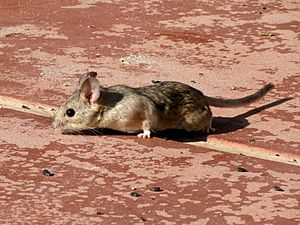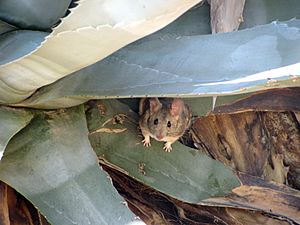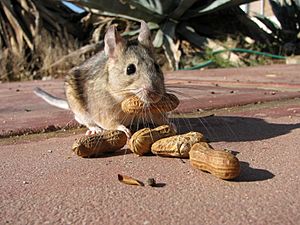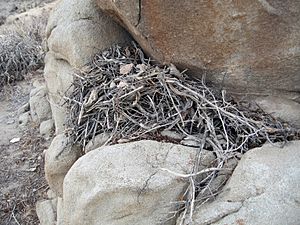Desert woodrat facts for kids
Quick facts for kids Desert woodrat |
|
|---|---|
 |
|
| Conservation status | |
| Scientific classification | |
| Genus: |
Neotoma
|
| Species: |
lepida
|
The desert woodrat (Neotoma lepida) is a type of pack rat that lives in the desert areas of western North America. These small animals are also known as packrats because they collect and store many different items in their homes.

Contents
What Does a Desert Woodrat Look Like?
Desert woodrats are fairly small for pack rats. They grow to be about 28 to 39 cm (11 to 15 in) long. This measurement includes their tail, which is 12 to 20 cm (4.7 to 7.9 in) long. They weigh from 122 to 350 g (4.3 to 12.3 oz). Male woodrats are usually bigger than females.
Their fur color can be different for each animal. It can range from light gray to a reddish-brown or even almost black. However, their bellies and feet are always white. The fur on their throat is pale but gray at the bottom. Their tail has two distinct colors and is quite hairy. It has fewer scales than the tails of brown rats. Desert woodrats have a thin nose, long whiskers, and ears that are quite long.
Where Do Desert Woodrats Live?
Desert woodrats can be found in many places. Their home range stretches from southeastern Oregon and southwestern Idaho. It goes south through Nevada and western Utah to California in the United States. They also live in Baja California and the very northwestern part of Sonora in Mexico.
They often live in areas with sagebrush plants. You can also find them in chaparral areas. They like deserts and rocky hillsides. These places usually have scattered cactus, yucca, pine/juniper trees, and other low plants. They can live at high elevations, up to 2,900 m (9,500 ft). They are most common in rocky spots. This is because rocks offer many cracks and piles where they can hide from animals that hunt them.
What Do Desert Woodrats Eat?
Desert woodrats eat many different plants. They enjoy the beans and leaves of mesquite trees. They also eat parts of juniper plants and various cacti. It seems the cactus spines do not hurt them. Other foods include creosote bushes, thistles, Ephedra, Mustard plants, sagebrush, and buckwheat.
They also eat other green plants, seeds, fruits, acorns, and pine nuts. In the desert, they really depend on prickly pear cacti. This helps them get enough water. They can also survive on creosote bushes all year. Some plants, like creosote bushes, have high levels of certain chemicals. Eating too much of these can affect how much water the woodrats need. This can also limit what other foods they can eat.
Who Hunts Desert Woodrats?
Many animals hunt desert woodrats. These include snakes, owls, hawks, coyotes, foxes, and weasels. Other meat-eating mammals also hunt them.
How Do Desert Woodrats Have Babies?
Desert woodrats have their babies in the spring and summer. A mother woodrat can have up to five young at a time. The babies are born after about 30 to 36 days. When they are born, the young weigh about 10 g (0.35 oz). They are blind, and only the tips of their fur can be seen. Their eyes open after about ten days.
Newborn desert woodrats have a special way of holding on. Their teeth are spread apart at first, making a shape like a hexagon. This allows them to clamp onto their mother's teats very tightly. It's hard to separate them! Their teeth become normal after about twelve days. The young woodrats are fully weaned, meaning they stop drinking milk, around four weeks old. In safe places like zoos, they can live for up to five years.
How Do Desert Woodrats Behave?
Desert woodrats are mostly active at night. They are also very solitary, meaning they like to be alone. They might protect water sources, like succulent plants, from other animals. This can stop other species from getting water during dry times.
Desert woodrats sometimes take over the homes of ground squirrels or kangaroo rats. They make the entrance stronger by adding many sticks and pieces of plants. They often use parts from jumping and teddy-bear cholla cacti. This creates a very strong defense against animals that want to eat them. Their homes are also often built against rocks, at the bottom of creosote or cactus plants, or in the lower branches of trees. They seem to prefer rocky areas if they can find them. But pack rats can usually adapt to living in any situation.
Woodrats build houses for sleeping, storing food, and escaping from predators. These houses can have up to six entrances. They can also have eight rooms inside, including nests and places to store food. It's not unusual for a house to be 36 cm (14 in) tall and about 100 cm (39 in) wide at the bottom. Nests are made from dry plants, often grassy parts or shredded stems.
Male woodrats mark their territory by rubbing their bodies on the ground. They leave behind a musky oil from special glands on their belly. Female woodrats mark their territory differently. They first dig, then rub their sides, legs, or cheeks on the dirt they dug up. Desert woodrats are active all year long.
Images for kids





